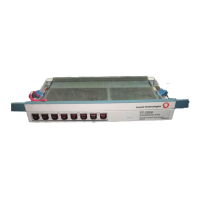Maintenance Description
Issue 8.0 July 2002
9-47
Optical Low Speed Protection — (OC-3) 9
General 9
The FT-2000 OC-48 Add/Drop-Rings Terminal equipped with Release 5.0.1-ADR
or later software provides optical low-speed protection of an OC-3 line. Optical
low-speed protection switching takes place in response to automatically detected
faults and external commands from a local/remote CIT or operations system.
Refer to the FAULT-Switch-OC3 input in Volume I, Section 11, "Craft Interface
Terminal Usage."
NOTE:
For intra-office applications, the IS-3 Optical Interface may be used and it
retains all of the same considerations given to the OC-3.
Table 9-6 shows the standard protection switching priorities in descending order
of priority used by the FT-2000 OC-48 Add/Drop-Rings Terminal.
An OC-3 line may operate unprotected (0x1) or use provisionable unidirectional
1+1 nonrevertive protection switching. In unidirectional 1+1 nonrevertive
switching, the transmitting terminal transmits the same signal on two lines. The
receiving terminal monitors the two lines independently and chooses one line as
the active line and the other line as the standby line. When a protection switch
occurs, the receiving terminal selects the signal from the standby line which
causes the standby line to be the new active line. The original active line becomes
the standby line. This status remains the same (nonrevertive) after the fault
clears. Protection switching is performed in one direction only (unidirectional).
Table 9-6. Optical Low Speed Protection Switching Priorities
Switch Priority (Descending Order) Source of Request
Reset* CIT/OS
Switch inhibit CIT/OS
APS channel failure Automatic
Lockout of protection CIT/OS
Lockout of service CIT/OS
Forced switch CIT/OS
Signal fail Automatic
Signal degrade Automatic
Manual switch CIT/OS
* Resetting the OC-3 switch priority
(FAULT-Switch-OC3-Priority:Reset) has no effect on any
automatic switch priority.

